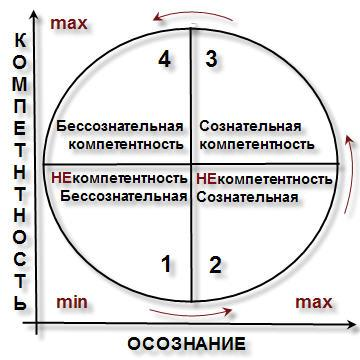NLP: The Model of Change
Hello everyone, this is Stalilingus! Today I want to talk to you about a topic that marks the beginning of every NLP course (and I think it’s discussed in many other educational programs as well).
The topic is: The Learning Cycle, also known as the “Model of Change.”
The Four Stages of Learning
In the diagram, we see a Cartesian coordinate system with the axes of awareness and competence. The intersection of these axes creates four sectors:
- Unconscious Incompetence / Unconscious Ignorance
- Conscious Incompetence / Conscious Ignorance
- Conscious Competence / Conscious Knowledge
- Unconscious Competence / Unconscious Knowledge
These are the four states we can be in when learning something, whether it’s a skill or knowledge.
Let’s Break Down Each Stage
- Unconscious Incompetence (Unconscious Ignorance): This is when a person doesn’t even realize that they don’t know something. In other words, they’re not aware that a certain area of knowledge exists at all. (Like those who don’t know about the Learning Cycle and don’t even know it exists.)
- Conscious Incompetence (Conscious Ignorance): This is when a person is aware that they don’t know something. For example, right now you might be in a state of conscious ignorance: you know the Learning Cycle exists, but you don’t know what it is yet.
- Conscious Competence (Conscious Knowledge): Here, you have the knowledge or skill, but to use it well, you need to focus your attention. For example: I consciously try new techniques in communication. I’m focused when learning a new move or method.
- Unconscious Competence (Unconscious Knowledge): Simply put, this is a skill you can perform automatically, without thinking. Or knowledge you can share easily, as if you were born with it (like poems you still remember from school).
Now that we understand the meaning of each sector, let’s look at how we actually learn. Or, in the language of the Learning Cycle model, how we move from one sector to another—from the first state to the fourth. The conscious path involves three transitions: motivation, learning, and practice. The unconscious path is the fourth—imprinting, which is a direct leap from unconscious incompetence to unconscious competence.
Imprinting a Skill
We have little control over this process. It depends on the person we choose to learn from. If they’re not a professional teacher, we’ll unconsciously pick up their skills by directly copying their behavior. That’s how we learned from our parents. If they’re an NLP trainer, the skill can be imprinted on us regardless of our conscious efforts.
Practical advice: try to regularly interact only with people you want to become more like. Avoid those whose “aura” you don’t want to catch.
Motivation
This is the transition from unconscious incompetence to conscious incompetence. It’s often called problem awareness, because it’s the realization of your own lack of knowledge or skill. This can be unpleasant or even painful, but it’s necessary. To solve a problem, you first have to admit it exists.
It’s hard to overcome a fear you don’t recognize. It’s tough to become a pleasant conversationalist if you don’t notice when you’re being unpleasant. You can’t learn to drive if you’re convinced you already drive perfectly.
Awareness of your own incompetence often comes from reflecting on the reasons for unfairness in life. For example: Why do some people have a lot of money and others don’t? Why are some people popular and others are pushed away?
Learning
At this stage, it’s important to keep trying. It’s important to pay attention to all feedback. Don’t expect too much from yourself here.
Practice
This is the process of turning a skill into a habit. It’s achieved through regular practice—at every opportunity, whenever possible, constantly, and with ongoing enjoyment of your growing expertise.
The point of practice is to get real benefits from your skill. The ability to walk lets you reach the jam. The ability to communicate brings me a good income. The ability to set goals correctly leads to my wishes coming true.
You know that if you practice often enough, the skill becomes automatic, and you no longer need to spend so many resources on it. On the contrary, your actions become refined and elegant. You can even do something else at the same time—like learning a new skill. But that’s the next cycle.
I hope this knowledge helps you.
Yours, Stalilingus



